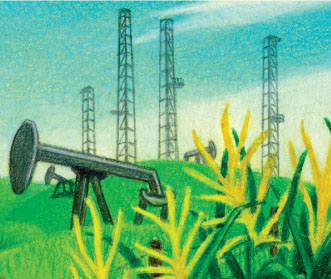 One sector of the energy industry that hasreceived major attention in recent years—very little of itpositive—is shale-gas drilling using hydraulic fracturing, or“fracking.”
One sector of the energy industry that hasreceived major attention in recent years—very little of itpositive—is shale-gas drilling using hydraulic fracturing, or“fracking.”
But despite the surge of negative PR over the last few years,fracking is not a new concept. “It has been around for years,”notes Robert Rokicki, senior vice president of Oil, Gas,Petrochemical and Chemical Property for Liberty InternationalUnderwriters. “The exposures are not that different” from otherenergy-extraction operations, he adds.
|What has changed: Fracking is being used to a greater extent, inmore areas—some highly populated—in an effort to extract naturalgas and oil from the ground using water and chemicals.
|A core of traditional, well-established insurers remains“relatively comfortable” with the risks associated with fracking,says Bertol Olsson, Energy practice leader for North America atMarsh.
|Other carriers, Olsson adds, “aren't in it 100 percent”—meaningthey will be more selective in the risks they assume and coveragesthey offer to this industry.
|Stuart Anderson, CEO of Iron-Starr, a managing generalunderwriting agency representing Ironshore Insurance and the CVStarr Group of companies, says the fracking industry presentsopportunity for an underwriter with the right knowledge. Iron-Starrhas sent some of its underwriters to “shale school” and has metwith lawyers and operators in order to grasp the risks of thebusiness.
|“There is significant exposure—from the risk of blowout to therisk of 50 trucks fueling around a pipeline at the same time,” saysAnderson. “It has to be underwritten closely.”
|The issue of experienced personnel has become a concern asfracking expands in the U.S., says Rick Gibbons, president ofZurich Global Energy.
|“Millions of jobs are said to be created in the near future andthat's good, but who are these people [on the project]?” Gibbonsasks. “Are they trained?”
|Gibbons also notes that “the supplies [required for fracking]are tremendous.”
|Perhaps the biggest insurer concern around fracking is theuncertainty around legislation and potential lawsuits.
|Olson observes that insurers are not so much “concerned with theprocess” of fracking, or the equipment or technology used; theirconcern centers around “public opinion—litigation and politics,”Olsson says.
|“The difficulty is not that drillers are doing something new anddangerous, but that the activity has a higher profile with a moreenergized environmental lobby,” brokerage Willis says of frackingin a 2012 energy market report.
|Indeed, a simple Internet search reveals dozens of litigationcases stemming from the practice and alleged resulting pollutionand contamination of water sources.
|And with such complex and unresolved issues at play, it is nostretch to come up with scenarios in which it is difficult toconclude whether certain coverage is applied or excluded. And itmight be as difficult to predict which jurisdictions lean morefavorably toward plaintiffs.
|But as with any risk, it's all in the underwriting. Thewillingness of insurers to write the risks associated with frackingdepends on whether those involved in the operations apply bestpractices to reduce the potential for accidents.
|A final note on fracking: Shale gas drilling is not limited tothe U.S., says Gibbons of Zurich. There was a recent “huge find” inChina, for example, but the infrastructure to start operationsdoesn't yet exist, he adds.
Want to continue reading?
Become a Free PropertyCasualty360 Digital Reader
Your access to unlimited PropertyCasualty360 content isn’t changing.
Once you are an ALM digital member, you’ll receive:
- All PropertyCasualty360.com news coverage, best practices, and in-depth analysis.
- Educational webcasts, resources from industry leaders, and informative newsletters.
- Other award-winning websites including BenefitsPRO.com and ThinkAdvisor.com.
Already have an account? Sign In
© 2024 ALM Global, LLC, All Rights Reserved. Request academic re-use from www.copyright.com. All other uses, submit a request to [email protected]. For more information visit Asset & Logo Licensing.








